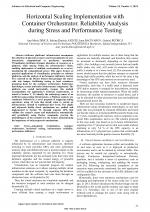| 3/2024 - 3 |
Horizontal Scaling Implementation with Container Orchestrator. Reliability Analysis during Stress and Performance TestingDINCA, A.-M. |
| Extra paper information in |
| Click to see author's profile in |
| Download PDF |
Author keywords
automated virtualization, container orchestrator, horizontal scaling, infrastructure reliability, performance indicators
References keywords
software(9), cloud(9), kubernetes(7), docker(6), computing(6), applications(5), technology(4), performance(4), orchestration(4), network(4)
Blue keywords are present in both the references section and the paper title.
About this article
Date of Publication: 2024-08-31
Volume 24, Issue 3, Year 2024, On page(s): 23 - 32
ISSN: 1582-7445, e-ISSN: 1844-7600
Digital Object Identifier: 10.4316/AECE.2024.03003
Web of Science Accession Number: 001306111400003
SCOPUS ID: 85202992366
Abstract
Software platforms infrastructure encompasses the collection of physical resources used concomitantly for user interactions, computational or persistence operations. Virtualization facilitates dynamic allocation of resources to a platform, while staying within the infrastructure's limits, enabling deployments of multiple environments on a server, maximizing the computational power. This paper focuses on practical applications of virtualization principles on software platforms, and the analysis of performance indicators. Section II is centered on the Docker feature that packages the source code into images, facilitating testing in local containers, preparing them for the container orchestrator, Kubernetes that designs, creates and scales infrastructure components. The platform was scaled horizontally, because this method accommodates the applications technical requirements, as stated in Section V. To identify the underlying causes of an inefficient auto-scaling infrastructure, a Fishbone analysis was conducted, followed by a novel proposal of triggering scaling operations, using AI tools that decide when to rescale an infrastructure, instead of traditional alert levels. The simple and advanced health check mechanisms are studied and implemented in Section VI, through separate APIs that validate the systems status and dependencies automatically and periodically using Docker commands, proving the misleadingness of the container for the former, demonstrating the importance of such progressive mechanisms. |
| References | | | Cited By |
Web of Science® Times Cited: 0
View record in Web of Science® [View]
View Related Records® [View]
Updated 2 days, 23 hours ago
SCOPUS® Times Cited: 0
View record in SCOPUS® [Free preview]
There are no citing papers in the CrossRef Cited-by Linking system.
Disclaimer: All information displayed above was retrieved by using remote connections to respective databases. For the best user experience, we update all data by using background processes, and use caches in order to reduce the load on the servers we retrieve the information from. As we have no control on the availability of the database servers and sometimes the Internet connectivity may be affected, we do not guarantee the information is correct or complete. For the most accurate data, please always consult the database sites directly. Some external links require authentication or an institutional subscription.
Web of Science® is a registered trademark of Clarivate Analytics, Scopus® is a registered trademark of Elsevier B.V., other product names, company names, brand names, trademarks and logos are the property of their respective owners.
Faculty of Electrical Engineering and Computer Science
Stefan cel Mare University of Suceava, Romania
All rights reserved: Advances in Electrical and Computer Engineering is a registered trademark of the Stefan cel Mare University of Suceava. No part of this publication may be reproduced, stored in a retrieval system, photocopied, recorded or archived, without the written permission from the Editor. When authors submit their papers for publication, they agree that the copyright for their article be transferred to the Faculty of Electrical Engineering and Computer Science, Stefan cel Mare University of Suceava, Romania, if and only if the articles are accepted for publication. The copyright covers the exclusive rights to reproduce and distribute the article, including reprints and translations.
Permission for other use: The copyright owner's consent does not extend to copying for general distribution, for promotion, for creating new works, or for resale. Specific written permission must be obtained from the Editor for such copying. Direct linking to files hosted on this website is strictly prohibited.
Disclaimer: Whilst every effort is made by the publishers and editorial board to see that no inaccurate or misleading data, opinions or statements appear in this journal, they wish to make it clear that all information and opinions formulated in the articles, as well as linguistic accuracy, are the sole responsibility of the author.





